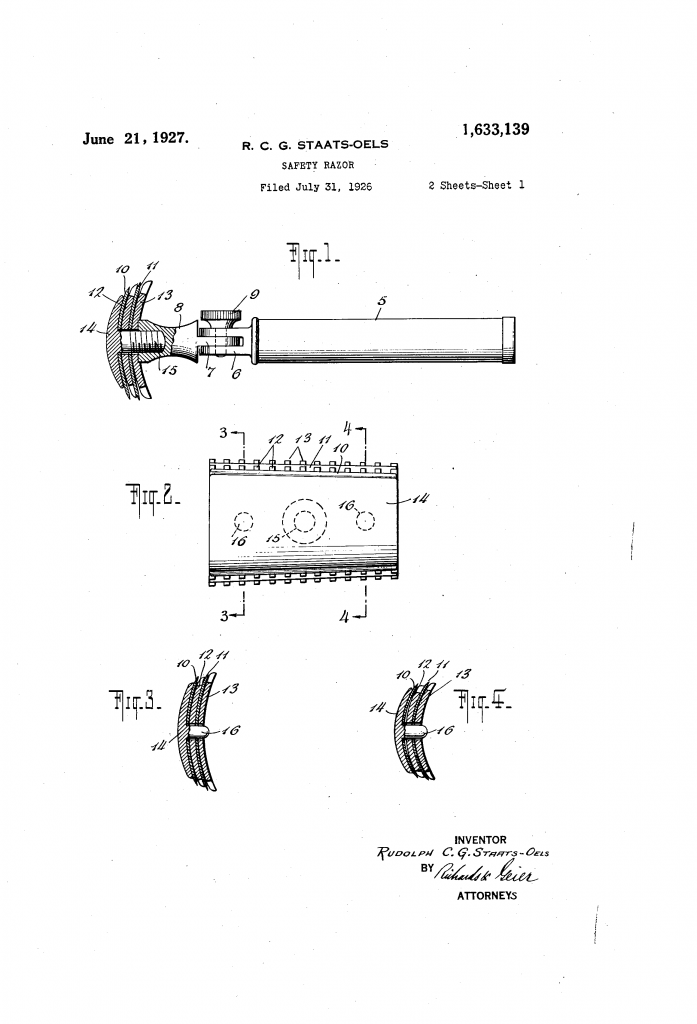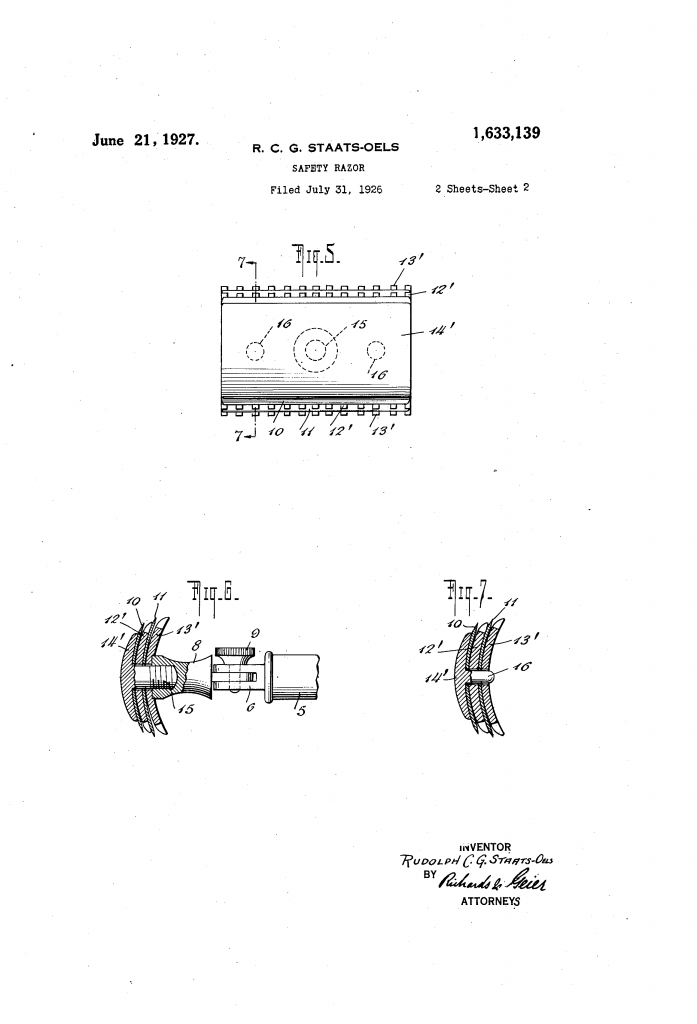In 1926 Rudolph C G Staats-Oels filed a patent for an improvement in safety razors. I’m not sure how much of an improvement it was. It was certainly novel, by the standards of the day. For starters, it was a slant. Or as the patent put it, it had a head:
…wherein the transverse curvature of the blade will be gradually increased from one end toward the other thereof.
From US patent 1,633,139
Two blades for… reasons.
The slantiness was just part of the invention though, and perhaps not the most important one. Touted before the transverse curvature was the ability to mount not just one, but two blades. While those of us who swear to traditional wetshaving1 knows the benefit of using a single blade, Mr Staats-Oels claimed that using two would be beneficial. I think he was wrong, but let us see what the patent text says:
…mounting a pair of blades thereon in such manner that a repetition of the shaving operation is obtained with every stroke of the-razor…
Also by providing a pair of blades, it will be apparent that with every stroke of the razor the shaving of a given area will be repeated.
From US patent 1,633,139
Blissfully free of the modern claim of a closer2 shave, the main claim seems to be saving time and effort. This was achieved by having – in essence – two base plates. While the upper of the two blades may appear slightly narrower in the drawing, there is no mention in the patent text of the blades being of different width. It’s likely that the curvature was different though, so that the lower cutting edge jutted out a little further.
It seems Mr Staats-Oels wasn’t happy with just two blades either. A slightly scary portion of the patent hints at the possibility of stacking more guard plates and blades. To quote:
It is to be noted that although only two blades are shown and described, a larger number may be employed with equal facility by the use of a corresponding number of guards.
From US patent 1,633,139
So according to the patent text, a ten or even fifteen blade razor would be an option. One shudders to think of such things.
Slanted goodness
While a modern slant is twisting the blade, Staats-Oels achieved it by changing the curvature along the long axis of the blade. In other words, the blade was flatter on one end than the other. In the words of the patent:
As is customary with razors of this type the guards and clamping plate are curved transversely, but in contradistinction to the usual type, instead of curving said blades uniformly throughout their lengths, the curvature of the guards and clamping plate in the present device is gradually increased from one end thereof toward the other, as best indicated in Figures 3 and 4. Thus, when the mounting 8 is threaded upon the extension 15 in the usual manner to clamp the guards and blades against the inner surface of the clamping plate, the blades, being flexible, will be caused to assume the same curvature as the guards and plate. With the blades thus-curved the cut ting edges thereof are so disposed that when the same are engaged with an area to be shaved they will have, in effect, a shearing action designed to facilitate the shaving operation.
From US patent 1,633,139
There is an interesting side effect to this way of making a slant. While a modern slant – like my Merkur 39C and white Bakelite slant – are identical on both sides, Mr Staats-Oels’ razor would have two sides that would slant in two different ways. Or put another way; if you held it so the slant was towards the right, and then turned it around… the slant would be towards the left.
I don’t know if that last bit would have a practical effect on the shaving. It is a neat feature regardless.
Patent drawings
Mr Staats-Oels included two sets of almost identical drawings with his patent. Only a closer inspection reveals that the first set shows the slated razor, while the second shows a razor without the slanted feature.


Final thoughts on Rudolph C G Staats-Oels’ razor
Mr Staats-Oels seems to think that his razor would benefit surgeons shaving patients. This was – he claimed – because it would be so effective at removing hair. Colour me less than convinced.
He also included a feature barely mentioned in the text; The ability to adjust the angle of the handle, much like Otto Spahr’s razor patented in 1926. This would to me be of doubtful benefits, since the razor is a proper slant. It could be handy if shaving others though.
The idea of stacking multiple blades in a safety razor isn’t new. The Italian Multiplex from ’33 comes to mind, for starters. There was also a two blade double edge razor being made around the time I started proper shaving3, but that seem to have sunk with no trace.
I wouldn’t mind seeing someone copy the gradually increasing curvature for making a new slanted razor. I just hope no one decides to copy the stacking of blades and guards. One blade is more than enough for a close shave.
The full patent text can, as usual, be viewed at Google Patents.
Footnotes
- I.e.: shaving with a brush, soap or cream, and a safety razor which have a replaceable blade not encapsulated in a cartridge.
- Even if the increased closeness requires a micrometer to measure…
- About a decade ago – if anyone recall this and remembers the name, please let me know.
